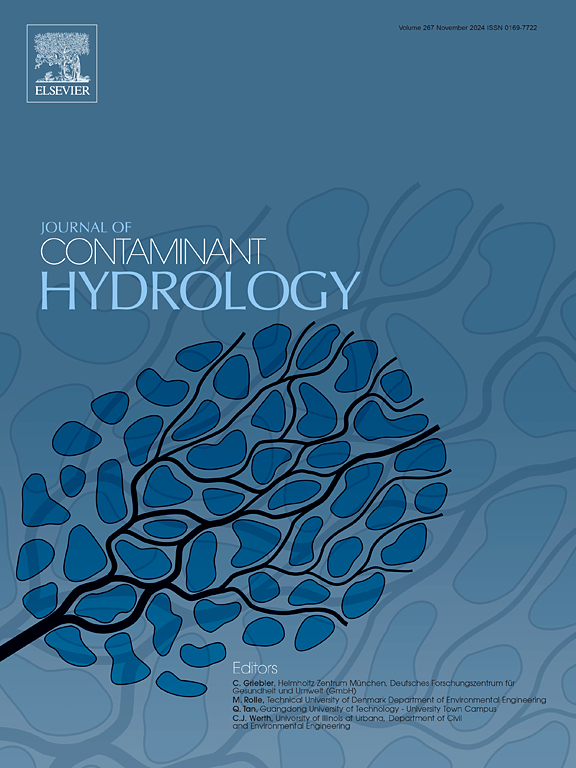Establishing a silica gel zone in well annulus and evaluating its performance in blocking vertical water flow
IF 3.5
3区 环境科学与生态学
Q2 ENVIRONMENTAL SCIENCES
引用次数: 0
Abstract
Wells are often constructed for monitoring purposes with relatively long screen lengths (e.g., >10 m). Vertical water flows can occur within the artificial or natural filter pack annulus that surround the screened interval, bypassing packer assemblies installed inside the wellbore. Attempts to isolate discrete vertical zones during groundwater sampling are unsuccessful when annular vertical flow occurs which lead to remedy decisions based on biased or incorrect interpretations. Blocking vertical annular water flow and contaminant transport will help obtain more accurate concentrations of contaminants from sampling in targeted depth intervals. The application of silica gels formed from the injected colloidal silica (CS) suspensions is a novel approach to minimize or prevent vertical movement of groundwater in the surrounding filter pack annulus. In this study, we tested the feasibility of injecting CS suspensions to target locations and developed a modified CS formulation that is injectable and prevents gravity sinking. We studied the spatial distribution and penetration of silica gel at laboratory scale in model well annulus with surrounding formations. We evaluated the performance of the silica gel in blocking vertical water flow in the annulus and in minimizing chemical transport through the gel zone. CS suspension formulations have been defined that are ready for injection, persist in target locations, and form gel within desired time frames. Injection of CS suspensions achieved uniform distribution in a well annulus filter pack, fully occupied the annulus pore space, and penetrated the formation surrounding the filter packer with a sufficient distance to create a hydraulic annular seal when the injection was applied at a sufficient rate. Silica gel that formed in the annulus blocked vertical water flow and stopped the chemical transport through the gel zone. This research reveals that using CS suspension injection and sequential gelation (CS-GEL) is a promising technology for blocking vertical water flow and chemical transport through the filter pack in targeted zones within the annulus of long-screened well systems.
在井环空建立硅胶层,并评价其阻断垂向水流的效果
井的筛管长度通常相对较长(例如10米),垂直水流可以发生在环绕筛管段的人工或天然过滤包环空中,绕过安装在井筒内的封隔器总成。当发生环空垂直流动时,试图在地下水采样期间隔离离散垂直带是不成功的,这导致基于有偏差或不正确解释的补救决定。阻断垂直环空水流和污染物输送将有助于从目标深度区间的采样中获得更准确的污染物浓度。应用由注入的硅胶胶体悬浮液(CS)形成的硅胶是一种减少或防止地下水在周围过滤包环空垂直移动的新方法。在这项研究中,我们测试了将CS悬浮液注入目标位置的可行性,并开发了一种改良的CS配方,该配方可注射并防止重力下沉。在实验室尺度上研究了硅胶在模型井环空和周围地层中的空间分布和渗透情况。我们评估了硅胶在阻断环空垂直水流和减少通过凝胶区的化学物质输送方面的性能。CS悬浮液配方已经被定义为可以注射,持续存在于目标位置,并在所需的时间框架内形成凝胶。CS悬浮液的注入实现了环空过滤包内的均匀分布,充分占据了环空孔隙空间,当注入速度足够大时,CS悬浮液能够穿透过滤封隔器周围的地层,形成水力环空密封。在环空形成的硅胶阻断了水的垂直流动,阻止了化学物质通过凝胶区的输送。该研究表明,CS悬浮液注入和顺序凝胶化(CS- gel)是一种很有前途的技术,可以在长筛井系统环空的目标区域阻断垂直水流和化学物质通过过滤包的输送。
本文章由计算机程序翻译,如有差异,请以英文原文为准。
求助全文
约1分钟内获得全文
求助全文
来源期刊

Journal of contaminant hydrology
环境科学-地球科学综合
CiteScore
6.80
自引率
2.80%
发文量
129
审稿时长
68 days
期刊介绍:
The Journal of Contaminant Hydrology is an international journal publishing scientific articles pertaining to the contamination of subsurface water resources. Emphasis is placed on investigations of the physical, chemical, and biological processes influencing the behavior and fate of organic and inorganic contaminants in the unsaturated (vadose) and saturated (groundwater) zones, as well as at groundwater-surface water interfaces. The ecological impacts of contaminants transported both from and to aquifers are of interest. Articles on contamination of surface water only, without a link to groundwater, are out of the scope. Broad latitude is allowed in identifying contaminants of interest, and include legacy and emerging pollutants, nutrients, nanoparticles, pathogenic microorganisms (e.g., bacteria, viruses, protozoa), microplastics, and various constituents associated with energy production (e.g., methane, carbon dioxide, hydrogen sulfide).
The journal''s scope embraces a wide range of topics including: experimental investigations of contaminant sorption, diffusion, transformation, volatilization and transport in the surface and subsurface; characterization of soil and aquifer properties only as they influence contaminant behavior; development and testing of mathematical models of contaminant behaviour; innovative techniques for restoration of contaminated sites; development of new tools or techniques for monitoring the extent of soil and groundwater contamination; transformation of contaminants in the hyporheic zone; effects of contaminants traversing the hyporheic zone on surface water and groundwater ecosystems; subsurface carbon sequestration and/or turnover; and migration of fluids associated with energy production into groundwater.
 求助内容:
求助内容: 应助结果提醒方式:
应助结果提醒方式:


